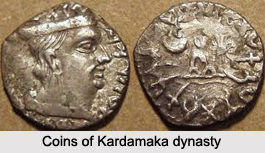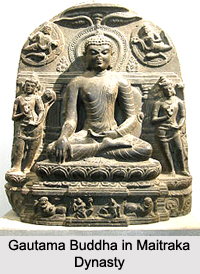 Early History of Gujarat deals with the glorious rule of Chandragupta Maurya and the Mauryan Dynasty. Chandragupta Maurya at first conquered a number of earlier states of Gujarat. Pushyagupta, a Vaishya, was appointed Governor of Saurashtra by the Mauryan regime. He ruled present Junagadh and built a dam on the Sudarshan lake. Emperor Ashoka, the grandson of Chandragupta Maurya, not only ordered engraving of his famous edicts on the rock at Junagadh, but asked his Governor Tusherpha to take out canals from the lake where an earlier Mauryan Governor had built a dam. Between the decline of the Mauryan power and Saurashtra coming under the sway of Samprati Mauryas of Ujjain, there was a Greek incursion into Gujarat led by Demetrius. In the first half of the first century A.D. there is the story of a merchant of King Gondaphares landing in Gujarat with Apostle Thomas.
Early History of Gujarat deals with the glorious rule of Chandragupta Maurya and the Mauryan Dynasty. Chandragupta Maurya at first conquered a number of earlier states of Gujarat. Pushyagupta, a Vaishya, was appointed Governor of Saurashtra by the Mauryan regime. He ruled present Junagadh and built a dam on the Sudarshan lake. Emperor Ashoka, the grandson of Chandragupta Maurya, not only ordered engraving of his famous edicts on the rock at Junagadh, but asked his Governor Tusherpha to take out canals from the lake where an earlier Mauryan Governor had built a dam. Between the decline of the Mauryan power and Saurashtra coming under the sway of Samprati Mauryas of Ujjain, there was a Greek incursion into Gujarat led by Demetrius. In the first half of the first century A.D. there is the story of a merchant of King Gondaphares landing in Gujarat with Apostle Thomas.
Saka Dynasty in Gujarat
From the start of the 1st century AD, Saka rulers played prominent part in Gujarat`s history. Weather beaten rock at Junagadh gives a glimpse of the Ruler Rudradaman I (100 AD) of the Saka satraps known as Western Satraps, or Kshatraps. Mahakshatrap Rudradaman I founded the Kardamaka dynasty which ruled from Anupa on the banks of the Narmada up to Aparanta region which bordered Punjab. In Gujarat several battles were fought between the south Indian Satavahana dynasty and the Western Satraps. The greatest ruler of the Satavahana Dynasty was Gautamiputra Satakarni who defeated the Western Satraps and conquered some parts of Gujarat in the 2nd century BC.
Kshatrapa dynasty in Gujarat
 Kshatrapa dynasty was replaced by the Gupta reign with the conquest of Gujarat by Chandragupta Vikramaditya. Vikramaditya`s successor Skandagupta has left an inscription (450 AD) on a rock at Junagadh which gives details of the repairs of the embankment, damaged by floods, of Sudarshan Lake by his Governor.
Kshatrapa dynasty was replaced by the Gupta reign with the conquest of Gujarat by Chandragupta Vikramaditya. Vikramaditya`s successor Skandagupta has left an inscription (450 AD) on a rock at Junagadh which gives details of the repairs of the embankment, damaged by floods, of Sudarshan Lake by his Governor.
Chalukya Dynasty in Gujarat
In the early 8th century some parts of Gujarat was ruled by the Chalukya dynasty. In the early 8th century the Arabs of the Umayyad Caliphate established an Empire which stretched from Spain in the west to Afghanistan and Pakistan in the east.
Arab Invasion in Gujarat
The Arab rulers tried to expand their Empire in the 8th century and invaded Gujarat but the Arab invaders were defeated by the south Indian general Pulakesi who was sent by the south Indian Emperor Vikramaditya II of the Chalukya Dynasty. After this victory the Arab invaders were driven out of Gujarat. Pulakesi received the title Avanijanashraya by Vikramaditya II for the protection of Gujarat. In the late 8th century the Kannauj Triangle period started.
Gurjara-Pratihara Dynasty and Rashtrakutas in Gujarat
The 3 major Indian dynasties are Gurjara-Pratihara Dynasty, south Indian Rashtrakuta Dynasty and the east Indian Pala Empire dominated Gujarat from the 8th to 10th century. During this period the northern part of Gujarat was ruled by Gurjara-Pratihara Dynasty and the southern part of Gujarat was ruled by the south Indian Rashtrakuta Dynasty. The southern Gujarat was ruled by the south Indian Rashtrakuta dynasty until it was captured by the south Indian ruler Tailapa II of the Western Chalukya Empire.
Solanki Dynasty in Gujarat
Solanki dynasty ruled Gujarat from 960 AD to 1243 AD. Gujarat was a major center of Indian Ocean trade, and their capital at Anhilwara (Patan) was one of the largest cities in India, with population estimated at 100,000 in the year 1000.



















